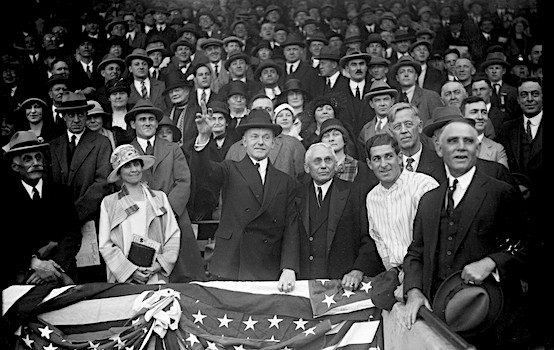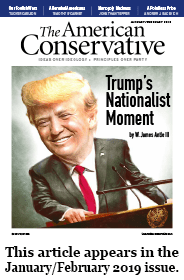Can American Capitalism Survive?

Capitalism in America: A History, Alan Greenspan and Adrian Wooldridge, Penguin Press, 496 pages
“I hear America singing…the United States is the greatest poem” — Walt Whitman
It’s not often that I read a book, mark it up on every page, and listen to the audio recordingto boot. Capitalism in America is a delightful romp through the 400-year economic life of America from agricultural giant to industrial juggernaut to information/technology revolutionary. Stories and statistics sparkle on every page.
But the book is more than a history. It is a policy guide to make sure capitalism in America flourishes like never before.

I seldom say this, but this book is required reading for anyone who cares about life, liberty, and prosperity in America. Capitalism in America is a celebration of free enterprise. The authors’ thesis is plain and simple: the giants of American business and enlightened Founding Fathers created the greatest form of democratic capitalism and a land of opportunity, resulting in “the highest standard of living in the world.” Former Federal Reserve chairman Alan Greenspan and Economist political writer Adrian Wooldridge (hereafter referred to as G&W) have written the best summary of American exceptionalism since John Chamberlain revealed the remarkable story of The Enterprising Americans in 1963.
Their heroes are the entrepreneurs, from Eli Whitney to Steve Jobs, and the intellectuals who advocated policies that encouraged the invisible hand of the marketplace, “shifting resources to more productive activities…creating new jobs and opening new enterprises.” Ayn Rand, Greenspan’s mentor, said it best: “Throughout the centuries there were men who took first steps down new roads armed with nothing but their own vision.” The results have been astonishing, leading the world in food production, industry, healthcare, transportation, finance, and entertainment.
Even the tycoons of the Gilded Age, known as the “robber barons,” are largely applauded: “For the most part…these businesspeople were neither ‘robbers’ nor ‘barons.’” Vanderbilt, Carnegie, and Rockefeller didn’t inherit wealth, but came from humble circumstances. In their chapter “The Age of Giants,” the authors declare, “The titans prospered by exploiting economies of scale rather than by price gouging. They prospered by creating markets…with ever-cheaper products.”
Carnegie offered “the best steel at the lowest price.” Rockefeller stabilized the oil industry and refining business, buying out competitors with generous stock offers, and “used his organizational genius to lower unit costs rather than to bilk the public.” Most were philanthropists extraordinaire. J.P. Morgan transformed the face of corporate America through the creation of new companies and mergers, the financing of the railroads, twice bailing out the U.S. government from default on its gold holdings, and saving the country from a financial panic in 1907. It’s like the authors took a page from Hillsdale professor Burt Folsom’s The Myth of the Robber Barons, though ironically G&W continued to use the pejorative term “robber barons” throughout the rest of the book.
Capitalism for the Masses
G&W’s favorite phrases are the “invisible hand” of Scottish philosopher Adam Smith and “creative destruction” of the Austrian economist Joseph Schumpeter. (I prefer the more accurate phrase “creative disruption.”) Smith’s “system of natural liberty” formed a “remarkable intellectual somersault,” the authors declare. Prior to 1776, when Smith wrote The Wealth of Nations, people “had generally regarded the pursuit of self-interest as, at best, unseemly, and at worst, sinful. Smith countered that, provided it took place within the constraints of law and morality, the pursuit of self-interest boosts the well-being of the entire nation.”
Indeed, America is living proof of Smith’s promise that his “system of natural liberty”—incorporating a trinity of freedom, competition, and justice—would increase the quantity, quality, and variety of goods and services, and therefore lead to “universal opulence which extends itself to the lowest ranks of the people.” The tycoons of the late 19th century created “the age of the common man.” As Carnegie boosted, “Capitalism is about turning luxuries into necessities.”
I learned many new facts and ideas from Capitalism in America. For example, G&W call the creation of the limited liability private corporation “the greatest single discovery of modern times.” Under the new business organization, anyone could create a company after paying a small fee and meeting some basic capitalization requirements. The private corporation could last beyond the grave, and could declare bankruptcy without personal liability. The authors declare, “It changed the balance of power between the state and the private sector: instead of businesspeople lobbying government for the privilege of incorporation, state governments lobbied business for the privilege of their presence.”
Indeed, G&W dedicate the most space in their book to the period from the end of the Civil War to America’s entry into the First World War “because it was the country’s greatest era of creative destruction.”
Political Roadblocks to Prosperity
The headwinds holding back the dynamic growth of American business include labor unions, misguided politicians, and academic intellectuals. Their influence rose rapidly after the First World War. G&W are Hamiltonian conservatives who favor the gold standard, free trade, private enterprise, and a small but powerful government. They are quick to indict the disastrous economic policies of Herbert Hoover, Franklin Delano Roosevelt, Lyndon Baines Johnson, Richard Nixon, and George W. Bush, among others. To summarize their impact:
Hoover’s response to the economic storm of the early 1930s was to raise taxes, sign the disastrous Smoot-Hawley tariff bill, and, through the Federal Reserve, fail to be a lender of last resort to commercial banks.
Despite being an “irrepressible optimist,” Roosevelt took advantage of the “Hoover Depression” to transform the American laissez-faire economy into “a Washington-dominated political economy.” He centralized power via “numerous mistakes,” such as the National Recovery Act, Agricultural Adjustment Act, the Wagner Act, and the National Labor Relations Act. The consequences were permanent entitlements such as Social Security, price fixing, regulation, cartels, anti-business rhetoric, and “a hodgepodge of often inconsistent policies” that postponed recovery for the entire 1930s. Only the Second World War bailed him out.
Roosevelt was followed by the relatively benign administrations of Truman, Eisenhower, and Kennedy, resulting in a post-war golden age of growth. But then came “Landslide Lyndon” Johnson, who took advantage of Kennedy’s assassination to push through a “massive expansion of the entitlement state” with Medicare, Medicaid, food stamps, and Aid to Families with Dependent Children. As a result, government spending and the national debt ballooned, and “government began to fail at everything it touched, from fighting poverty to fighting the North Vietnamese.”
Then Nixon came along and “presided over an even bigger expansion of the entitlement state than LBJ,” adding wage-price-rent controls, creating new agencies such as the Environmental Protection Agency, and taking America off the gold standard. The 1970s were an age of stagflation, energy crisis, and public negativity towards government.
The Ford-Carter era was followed by the “Age of Optimism,” bull markets on Wall Street, and a short-lived “end of big government” under Reagan, Bush 41, and Clinton.
The 9/11 terrorist attacks in 2001 allowed the “compassionate conservative” George W. Bush to be “the biggest government spender since his fellow Texan Lyndon Johnson.” Surpluses quickly disappeared, replaced by monstrous deficits. The financial crisis of 2008 elected Barack Obama, but the economy’s recovery was tepid after the passage of Obamacare and Dodd-Frank.
Which brings us to the present: “America’s Fading Dynamism.” G&W endorse some of President Donald Trump’s agenda, such as corporate tax cuts and deregulation, but not his “dangerous” trade policy. To “make America great again,” the nation, they advise, must address the more difficult problems of entitlement costs, our failing infrastructure, and the never-growing national debt. Most importantly, we must enjoy a vibrant financial sector with a stable monetary system. America needs to be on the move again as a “caravan” society, not a “citadel” society like Europe.
A Few Sins of Omission
There are a few sins of omission in the 496-page account. The authors missed a huge opportunity by leaving out perhaps the best case study of labor-capital relations in the 20th century: the famous Henry Ford $5-a-day story, when Ford made front page news by more than doubling overnight the wages of workers in 1914. In one brilliant move, he destroyed the Marxist arguments of exploitation and alienation. Ford shared his record profits with workers and for the first time employees could buy the product (the Model T) that they were making. Ever since then, the Marxists have bemoaned the revolutionary impact of what they call “Fordism.” This story is told in detail in most economic histories, including Jonathan Hughe’s The Vital Few, and I always make a point of discussing it with my students at Chapman University.
There are a surprising number of dynamic industries that are omitted in their history of post-war American business, such as sports franchises, advertising, publishing, and even the sex industry, which began in earnest under the demonic genius of Hugh Hefner and Playboy magazine.
Not surprisingly, the authors reject the popular view that the Federal Reserve, led by Greenspan, helped create the artificial boom in real estate prior to the financial crisis of 2008. They blame President George W. Bush’s “Blueprint for the American Dream” for subprime mortgages, and Wall Street for promoting high-risk and highly leveraged mortgage securities. Never mind that Greenspan’s Fed kept interest rates artificially low, as low as 1 percent, for several years prior to the crisis. Never mind that Greenspan and his successor Ben Bernanke were the chief bankers of the United States and did nothing to discourage fraudulent “no doc” and “subprime” mortgage loans, while other central banks in Canada, Australia, Switzerland, and other parts of the world maintained their high “prudent man” banking standards. It does not take much courage to “inject liquidity” after a monetary crisis hits. It’s taught in every money and banking class in college. But it does take wisdom and discipline to prevent a bubble from forming in the first place. And on that level both Greenspan and Bernanke failed.
Will American Capitalism Survive?
There has been a long-standing debate about the dynamic model that made America great. Can it continue? Schumpeter was pessimistic. “No,” he wrote, “I don’t think it can. Can socialism work? Of course it can.”
G&W disagree with Schumpeter on both counts. Socialism has failed wherever it has been tried. And they reject the pessimistic “secular stagnation” thesis of Robert Gordon, Tyler Cowen, and Larry Summers. America’s fading dynamism isn’t written in stone—our political leaders can take actions that will restore productivity if we address the entitlement and infrastructure challenges of our time, and reject protectionism and excessive regulation. G&W use Sweden as an example. After its 1991 fiscal and monetary crisis, the Swedish government introduced a succession of measures, including privatizing its social insurance company and cutting marginal taxes, so that the size of government has fallen from 67 percent to 49 percent of GDP. Sweden is now “the crown jewel of Europe.”
G&W are rightly worried about America being trapped in an “iron cage” of excessive taxation, regulation, and entitlements. They promise a daring escape, but first they need the right set of keys. The real question is, are there any statesmen left in America who are willing to use those keys?
Mark Skousen is a Presidential Fellow at Chapman University and was recently awarded the Triple Crown in Economics. He is the author of The Making of Modern Economics, and the producer of FreedomFest, “the world’s largest gathering of free minds,” in Las Vegas every July.